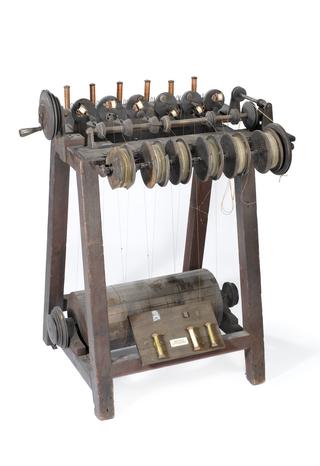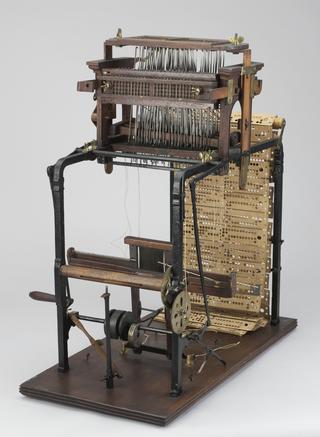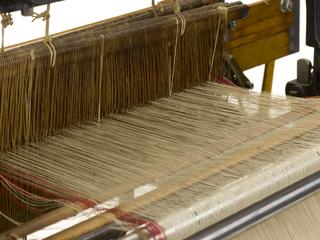
Model (scale 1:8) of a wool washing machine made by John & William McNaught
- Made:
- Rochdale

Model (scale 1:8) of a wool washing machine made by John & William McNaught, Rochdale, Manchester, England.
The machine represented by this model is one of a series of four through which the wool is passed in order to separate from it the impurities which consist of Yolk, or wool fat, Suint, or sheep's perspiration, and dirt. Yolk is insoluble in water and does not form soluble soaps with alkalies, but it emulsifies, and the washing process is based on this property. An inner tank with a perforated bottom is fixed inside a large tank. The inner tank holds the wool, which is propelled and agitated by a number of bars of brass prongs fixed to two long tubes which are lowered into the sud and then moved forward a short distance by means of cranks, cams, and levers. The forks at the delivery end of the machine are shortened and carry the wool over a chute and between rollers on to an apron which transfers it to the second machine in the series, and so on. The first machine has a bowl, or tank, 30 ft. long, the second 24 ft. long, the third 18 ft. long, and the fourth 12 ft. long. The liquor in the washing bowls consists of water heated up to a temperature of about 120 deg. F., with soap and sodium or potassium carbonate; but the fourth bowl usually contains hot water only, to rinse the wool. The fats rise to the top and are carried at the delivery end into a third or settling tank, from which they are flushed and from which the liquor is pumped from a point near the middle of this tank back into the washing bowl. The dirt falls through the perforations of the inner tank and is collected from one side of the bottom of the outer bowl, which is inclined. The propelling forks make from 15 to 18 strokes per minute and the delivery rollers make 8 revolutions per minute. 1,000 to 1,200 lb. of greasy wool per hour can be dealt with by a set of four bowls with an expenditure of 10 h.p. A sectional drawing of the machine is exhibited near the model.
Details
- Category:
- Textiles Machinery
- Object Number:
- 1914-751
- Materials:
- brass and polished wood
- Measurements:
-
overall: 330 x 300 x 920 mm
- type:
- washing machine
- credit:
- McNaught, John & William




